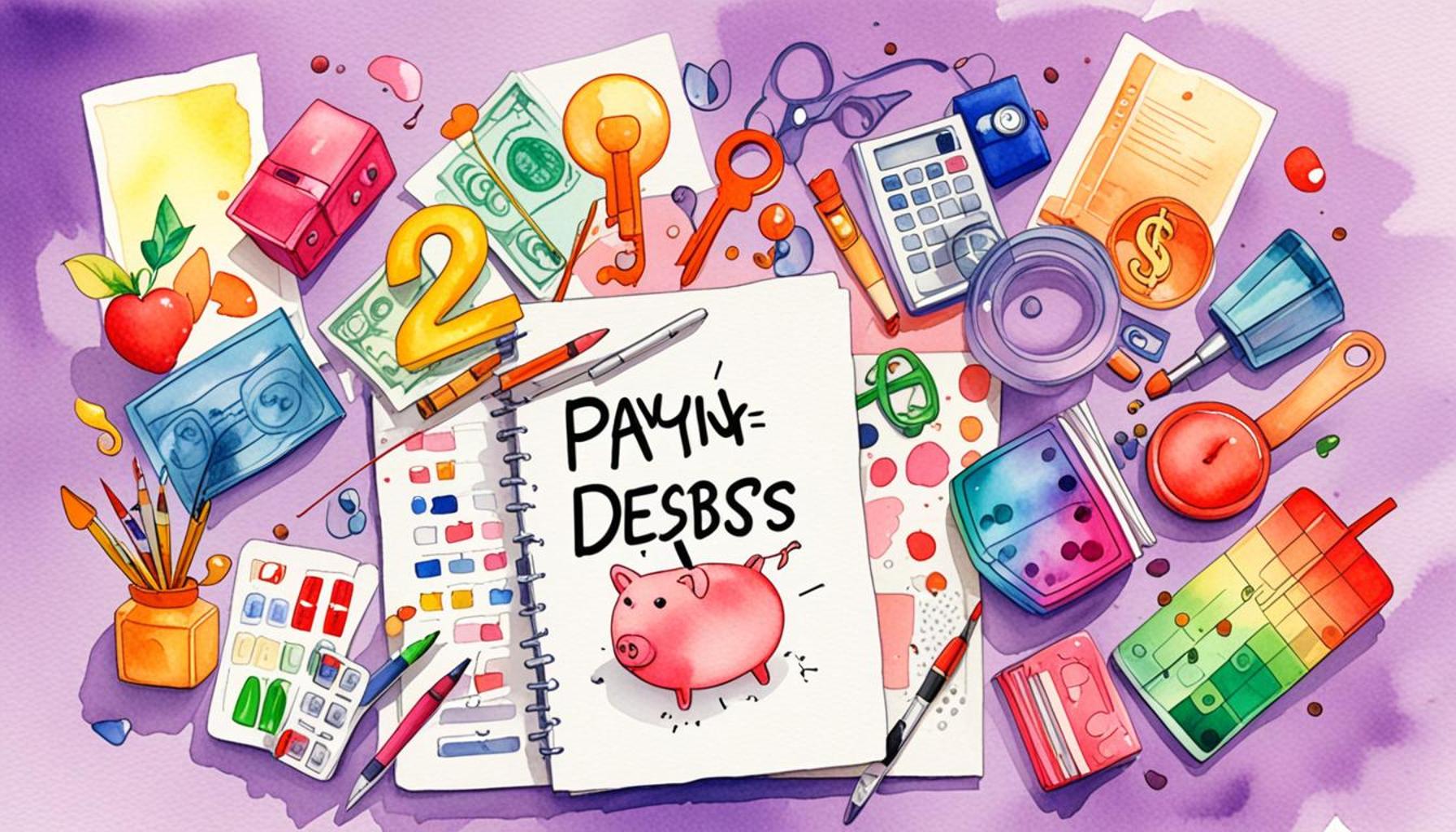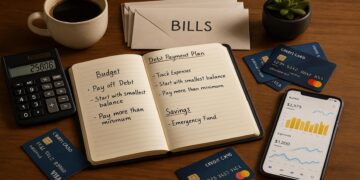Strategies for Paying Off Multiple Debts Simultaneously

Understanding Debt Management Strategies
Managing multiple debts can often feel like trying to juggle too many balls at once. When you have various loans, credit cards, and bills competing for your attention, it’s easy to feel overwhelmed. However, establishing a clear strategy is essential for regaining control of your financial situation and easing the burden of debt. By exploring different repayment strategies, you can find an approach that suits your needs and helps you on your journey towards financial stability.
It’s crucial to understand your options when forming a debt repayment plan. Here are three effective methods that can significantly streamline your debt repayment process:
- The Snowball Method: This strategy involves prioritizing your smallest debts first. By focusing on these smaller balances, you can achieve quick wins and build momentum. For instance, if you have three debts: a $500 credit card bill, a $1,500 personal loan, and a $5,000 student loan, you would first pay off the credit card. After eliminating this debt, the psychological boost can motivate you to tackle the next smallest debt.
- The Avalanche Method: In contrast to the Snowball Method, the Avalanche Method focuses on minimizing interest payments. You will pay off debts starting with the highest interest rates first, which can save you money over time. For example, if you have a credit card charging 18% interest, a personal loan at 10%, and a car loan at 5%, you would target the credit card debt first. This method can result in significant savings in interest payments.
- Debt Consolidation: Debt consolidation allows you to combine multiple debts into a single loan with a possibly lower interest rate. This approach can simplify payments and reduce interest. For example, if you have several high-interest credit cards, you could take out a personal loan with a lower interest rate and use it to pay off the credit cards. This not only makes tracking your payments easier but can also lower your total monthly payment.
Implementing these strategies—whether you choose the Snowball Method, the Avalanche Method, or Debt Consolidation—can significantly simplify your payments and help you achieve a debt-free life more efficiently. It’s essential to tailor your approach to your personal financial situation for optimal results.
Throughout this article, we will explore these strategies in more detail, providing practical tips and relatable examples to ensure you feel empowered to make informed financial decisions. Whether you’re dealing with credit card debt, student loans, or personal loans, having a well-thought-out plan can help alleviate your stress and set you on the right track toward financial freedom.
CHECK OUT: Click here to explore more
Choosing the Right Strategy for Your Situation
Understanding which debt repayment strategy aligns best with your financial situation is key to success. Each person’s circumstances are unique, and selecting an approach that resonates with your personal goals can enhance your motivation and progress. By breaking down these methods further, we can uncover the nuances that may guide you in making an informed choice.
Assessing Your Financial Health
Before diving into repayment strategies, it’s essential to assess your overall financial health. Start by listing all your debts, including the total amount owed, interest rates, and minimum monthly payments. This will give you a comprehensive view of your financial obligations. By having this information in one place, you can better understand your debt landscape and make informed decisions moving forward.
As you analyze your debts, consider the following factors:
- Total debt amount: How much do you owe in total? This will give you a clearer sense of the scale of your debt.
- Interest rates: What rates are associated with your various debts? Higher interest rates should be prioritized in order to minimize the total expense in the long run.
- Monthly obligations: What are your minimum payments for each debt? Knowing these will help you adequately allocate your budget towards debt repayment.
- Financial goals: What are your short-term and long-term financial goals? This will guide you in choosing a repayment method that aligns with your aspirations, whether that’s becoming debt-free faster or minimizing interest payments.
Creating a Budget Plan
Once you’ve assessed your financial health, the next step is to create a budget that accommodates your debt repayment strategy. A well-structured budget helps you balance your income, essential expenses, and debt payments without feeling stretched too thin. Here’s how to build an effective budget for your debt payment plan:
- Track your income: Determine your total monthly income, including your salary and any side earnings. Understanding your income is the backbone of your budget.
- Categorize your expenses: List all your necessary expenses, such as housing, groceries, utilities, and transportation. Understanding where your money is going ensures you can identify areas to cut back if needed.
- Allocate extra funds: After determining your essential expenses, allocate any surplus funds toward your debt repayment strategy. This is where you can apply any additional funds to your selected debt repayment method, whether that’s the Snowball or Avalanche approach.
By conducting a thorough assessment of your finances and crafting a detailed budget, you lay a strong foundation for successful debt repayment. This preparation equips you with the information necessary to implement your chosen strategy effectively and provides a roadmap towards achieving financial stability.
CHECK OUT: Click here to explore more
Implementing Effective Repayment Strategies
With a clear understanding of your financial health and a solid budget in place, it’s time to explore specific repayment strategies that can help you tackle multiple debts simultaneously. Two popular methods are the Debt Snowball and Debt Avalanche methods. Each has its merits, and choosing the right one depends on your personal preferences and financial situation.
The Debt Snowball Method
The Debt Snowball method involves focusing on paying off your smallest debts first while making minimum payments on larger ones. This strategy offers psychological benefits, as paying off smaller debts can create a sense of accomplishment and motivate you to continue. Here’s how to implement the Debt Snowball method:
- List your debts: Organize your debts from smallest to largest based on the total amount owed.
- Make minimum payments: While focusing on your smallest debt, continue to make the minimum payments on larger debts to avoid late fees or adverse impacts on your credit score.
- Focus on your smallest debt: Put any extra funds toward your smallest debt until it is paid off. The moment it is cleared, roll over the payment amount to the next smallest debt. This is known as the “snowball effect,” as your payments grow larger over time.
For instance, if you have three debts totaling $500, $1,500, and $2,500, you would target the $500 debt first. Once it’s paid off, you move the payment amount to the $1,500 debt, thus accelerating your journey towards debt freedom.
The Debt Avalanche Method
On the other hand, the Debt Avalanche method suggests focusing on debts with the highest interest rates first. This strategy can save you money in the long run by minimizing the interest paid over time. Here’s how to apply the Debt Avalanche method:
- List your debts: Organize all your debts in order of interest rate, from highest to lowest.
- Make minimum payments: Ensure that you are covering the minimum payments for all debts each month. This will safeguard your credit and keep you in good standing.
- Focus on high-interest debt: Direct any extra funds toward the debt with the highest interest rate. As you pay off that debt, continue this process down the list.
For instance, if your debts include amounts of $2,000 at 18% interest, $1,000 at 12%, and $3,000 at 5%, you would prioritize payments on the $2,000 debt due to its high interest. By reducing this first, you minimize the total interest paid overall.
Staying Motivated and Accountable
Regardless of the method you choose, maintaining motivation throughout the repayment process is essential. You may find it helpful to set small, achievable milestones. For example, celebrating when a debt is cleared or reaching a certain percentage of your total debt can provide positive reinforcement and encourage continued progress.
Accountability also plays a significant role. Consider partnering with a friend or family member to share your goals and updates. Alternatively, you could join an online community focused on debt repayment. Sharing your journey and challenges can foster support and help keep you engaged in your plan.
Remember, it’s crucial to remain adaptable throughout your repayment process. Life can present unexpected challenges, so be willing to reassess your budget and strategies as necessary. Being flexible with your approach will keep you on track and increase your chances of success in becoming debt-free.
SEE ALSO: Click here to read another article
Conclusion
In conclusion, paying off multiple debts simultaneously can be a daunting task, but with the right strategies in place, it becomes entirely manageable. By understanding your financial landscape and establishing a budget, you set the stage for successful debt repayment. The choice between the Debt Snowball and Debt Avalanche methods allows you to tailor your approach based on what motivates you most, whether it’s the quick wins from smaller debts or the long-term savings from tackling high-interest debts first.
Remember that motivation and accountability are key components of any debt repayment plan. Celebrating small victories and sharing your journey with others can provide the encouragement needed to remain committed. Additionally, staying flexible can help you navigate unexpected financial changes, ensuring that your repayment plan adapts to your life rather than constraining it.
It’s crucial to keep in mind that the road to becoming debt-free is not always linear. Challenges may arise, and that’s perfectly normal. The important thing is to stay focused and make consistent progress, no matter how small it may seem at times. By employing effective strategies and maintaining a positive attitude, you can regain control of your finances and work toward a future free of debt.

Linda Carter is a writer and financial consultant specializing in personal finance and money management. With years of experience helping individuals and families achieve financial stability and make informed decisions, Linda shares her expertise on the True Metronome platform. Her goal is to empower readers with practical advice and strategies to take control of their finances and build a secure future.





